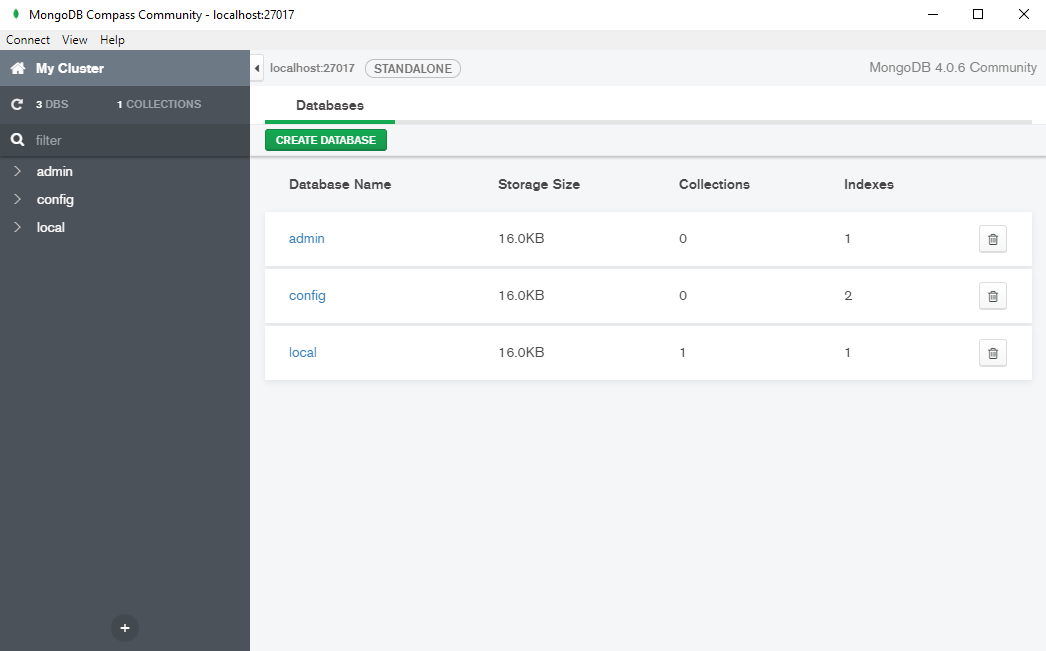

- #HOW TO START MONGODB SERVER FOR NODE JS HOW TO#
- #HOW TO START MONGODB SERVER FOR NODE JS INSTALL#
- #HOW TO START MONGODB SERVER FOR NODE JS DRIVER#
- #HOW TO START MONGODB SERVER FOR NODE JS PASSWORD#
- #HOW TO START MONGODB SERVER FOR NODE JS SERIES#
, l'événement est conçu pour aider les développeurs à découvrir de nouveaux produits et astuces, et sera rempli de contenu éducatif, de témoignages de clients, de démos techniques et de tutoriels pour vous aider à créer facilement des applications basées sur les données. MongoDB.local revient à Paris le 5 avril 2022Īprès une interruption de deux ans due à la pandémie, nous sommes heureux d'être enfin de retour à Paris pour
#HOW TO START MONGODB SERVER FOR NODE JS HOW TO#
How to react to database changes with change streams and triggers.How to implement transactions using Node.js.


#HOW TO START MONGODB SERVER FOR NODE JS DRIVER#
Official MongoDB Documentation on the MongoDB Node.js Driver In the meantime, check out the following resources:
#HOW TO START MONGODB SERVER FOR NODE JS SERIES#
Now that you're connected to your database, continue on to the next post in this series where you'll learn to execute each of the CRUD (create, read, update, and delete) operations. Today, you were able to connect to a MongoDB database from a Node.js script, retrieve a list of databases in your cluster, and view the results in your console. You will see output like the following: Databases: Now you’re ready to test your code! Execute your script by running a command like the following in your terminal: To see a copy of the complete file, visit the nodejs-quickstart GitHub repo. Save your changes, and name your file something like connection.js. We can use an instance of MongoClient to connect to a cluster, access the database in that cluster, and close the connection to that cluster. The MongoDB module exports MongoClient, and that’s what we’ll use to connect to a MongoDB database. Now that everything is set up, it’s time to code! Let’s write a Node.js script that connects to your database and lists the databases in your cluster. Connect to your database from a Node.js application Copy the provided connection string.įor more details on how to access the Connection Wizard and complete the steps described above, see the official documentation. When the Wizard prompts you to select your driver version, select Node.js and 3.6 or later. Next, the Wizard will prompt you to choose a connection method.
#HOW TO START MONGODB SERVER FOR NODE JS PASSWORD#
Be sure to note the username and password you use for the new MongoDB user as you'll need them in a later step. The Wizard will prompt you to add your current IP address to the IP Access List and create a MongoDB user if you haven't already done so. The Cluster Connection Wizard will appear. In Atlas, navigate to your cluster and click CONNECT. The final step is to prep your cluster for connection. It's free forever, and it's the easiest way to try out the steps in this blog series. Get started with an M0 cluster on Atlas today. If you're not familiar with how to create a new cluster and load the sample data, check out this video tutorial from MongoDB Developer Advocate Maxime Beugnet. Once your tier is created, load the sample data. At a high level, a cluster is a set of nodes where copies of your database will be stored. Head over to Atlas and create a new cluster in the free tier. The easiest way to get started with MongoDB is to use Atlas, MongoDB's fully-managed database-as-a-service. Create a free MongoDB Atlas cluster and load the sample data For more details on the driver and installation, see the official documentation. Running npm list mongodb will display the currently installed driver version number.
#HOW TO START MONGODB SERVER FOR NODE JS INSTALL#
npm install mongodbĪt the time of writing, this installed version 3.6.4 of the driver. If you don't have the MongoDB Node.js Driver installed, you can install it with the following command. You'll need the driver in order to connect to your database and execute the queries described in this Quick Start series. The MongoDB Node.js Driver allows you to easily interact with MongoDB databases from within Node.js applications.

See the MongoDB Compatability docs for more information on which version of Node.js is required for each version of the Node.js driver. For these examples, I've used Node.js 14.15.4. The current version of MongoDB Node.js Driver requires Node 4.x or greater. Install Node.jsįirst, make sure you have a supported version of Node.js installed. Before we begin, we need to ensure you’ve completed a few prerequisite steps.


 0 kommentar(er)
0 kommentar(er)
